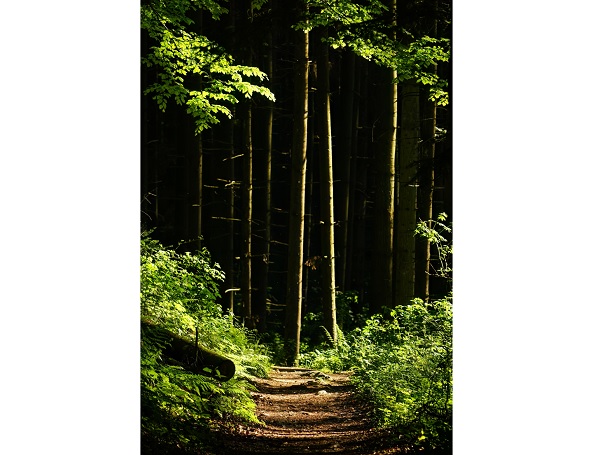 Credit: © Sören Salvatore
Credit: © Sören Salvatore
In the latest in a series of articles about current conservation issues, experts at natur&ëmwelt, a leading conservation NGO in Luxembourg, shared their insights with Chronicle.lu about the importance of forests, the types of forests and trees, the current state of forests and the vital connection we have with the trees around us.
Chronicle.lu: Forests are vital ecosystems. Can you explain this further?
Natur&ëmwelt: Forests are so much more than an amalgamation of trees. Contrary to the misconception that trees are inert matter and oblivious to the capacity and multi functions both above and belowground, forests are complex ecosystems where multiple species and individuals, grow, live and interact. Depending on the site conditions, such as soil exposition and climate, there are different forest types sheltering differing communities. They all provide essential resources – they regulate the climate and pull carbon from the atmosphere, releasing oxygen for us, providing habitat and food (everything is interconnected) and securing fresh water supplies. You get the gist! Do not forget the health benefits. Its spaciousness proves soothing to the many souls that frequent it. Yes, forest bathing is a thing. It is an all-round talent and it needs attentive care from our part.
Did you know that one-third of Luxembourg is surrounded by green, luscious forests? The forest area counts about 92,150 hectares (making it 35% of the surface). Luxembourg is covered in forests making it the "green fortress". The majority of the forests are private owned (around 52%) followed by municipality (34%), the state (13%) and public administrations (1%).
Chronicle.lu: Green fortress... What a poetic description! What types of trees are native to our green country?
Natur&ëmwelt: Beech is the most important broadleaf tree species, representing around 25% of the different forest types and is dominant in most deciduous forests. You can also find oaks, especially in the northern part of the country, where they were planted a century ago as coppice for the production of tannins. When it comes to coniferous forests, Norway spruce is the common tree, though recently many spruce stands are dying because of climate change and secondary pests like bark beetles or some fungi.
Chronicle.lu: Speaking of deciduous and coniferous, what are the differences?
Natur&ëmwelt: Deciduous trees have broad flat leaves, that are shed in autumn, after their most valuable components like nitrogen and minerals were transported and safely stored in the bark, the roots and the wood. This is why the leaves change their colour. Examples of deciduous trees are birch, maple, oak, beech. Conifers have needles and cones, and retain their foliage year round such as the pines, spruces, fir and lark (although larks do shed their needles in autumn). Their small, needle like leaves are covered by a thick layer of wax that protects them from frost.
Chronicle.lu: What can we you tell us about the health of our forests?
Natur&ëmwelt: The annual report of the Nature and Forest Administration does not show promising results. There has been an increase in the number of trees dying and at a faster rate. Two-thirds of trees in Luxembourg's forests are severely damaged or dying. Drought, heat and parasites have had a significant impact upon them. Included in the factors were discolouration, foliation and pathogens. Beeches are among the most affected tree species. However, the impact has also repercussions on oak trees. In short, new measures are required urgently.
Chronicle.lu: What can we do? How can we adapt to these drastic changes? What is our responsibility now?
Natur&ëmwelt: There are multiple ways to help steward and care for a healthy forest. Multiple functions of forests, also called ecosystem services, can only be guaranteed by a healthy forest and sustainable forest management.
Chronicle.lu: What does that mean, in more concrete terms?
Natur&ëmwelt: Right now, we are witnessing a dramatic change in our forests due to climate change. Especially old beech forests and spruce stands are rapidly disappearing, so that in only a few years we will have mainly young forests. To improve the resilience of these young forests we need to enhance their biodiversity by planting a large variety of indigenous trees that are adapted to the soil and other site conditions. By quickly restoring it, soil degradation can be minimised and most ecosystems services can be maintained. However, in many parts of the country the forests are endangered by too high game densities. Wild boar eat the acorns and beechnuts before they even germinate and roe deer and stags have a special appetite for young trees. Fenced control areas show that the diversity and the regeneration of trees disappears within reach. If we want to have healthy forests in the future, it is not sufficient to fence in young trees; the game density must be adjusted and well calibrated so that a species-rich forest can develop adequately.
We live in a new changing reality that necessitates new measures. Forests are vital to us in many ways and we need to protect them. On a personal level, there is the need to learn more about trees, to go out, pay attention and notice, to learn what happens above and below ground, to know the species' names and learn to identify them. To care for them.








